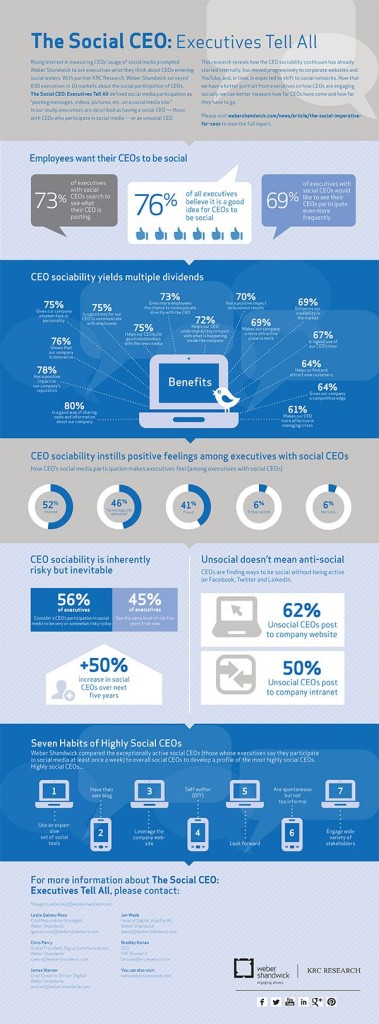 Social media has permeated business culture and is now considered an integral part of marketing. However, 60% of executives use social media less than one hour per week, and the network they are likely to use is LinkedIn. An even more disheartening survey by IBM found that only 16% of CEOs use social media. Why aren’t members of the C-suite using social media? And, perhaps more importantly, should they? For most executives, it boils down to a very simple question: how is this going to impact the business’s bottom line? A fair question and if you view social media as just that, social, you’re not going to be readily convinced of its upside. In addition, some executives are concerned about legal implications and their comments not being “vetted” by a team of publicists or lawyers. Let’s take a look at some of the benefits and how an executive can wade into social media.
Social media has permeated business culture and is now considered an integral part of marketing. However, 60% of executives use social media less than one hour per week, and the network they are likely to use is LinkedIn. An even more disheartening survey by IBM found that only 16% of CEOs use social media. Why aren’t members of the C-suite using social media? And, perhaps more importantly, should they? For most executives, it boils down to a very simple question: how is this going to impact the business’s bottom line? A fair question and if you view social media as just that, social, you’re not going to be readily convinced of its upside. In addition, some executives are concerned about legal implications and their comments not being “vetted” by a team of publicists or lawyers. Let’s take a look at some of the benefits and how an executive can wade into social media.
There are executives who are active on social media and clearly see the social media juggernaut not slowing down any time soon. Richard Branson, CEO of Virgin Group, wrote a post on LinkedIn about this very topic. He believes that because social media is a way in which more and more people are communicating, business executives should follow suit simply to engage with their customers and clients, building brand recognition and loyalty. In the financial services realm, Peter Aceto of Tangerine, formerly ING Direct, writes a blog and is on Twitter and Google+. According to a recent article on CIO.com:
“Social media is here to stay and it’s getting more dominant all the time in the sense of how our global community is informing itself of everything from invasions in Crimea to new products,” says Colin Moor, a partner at career consulting firm Essex Partners. “You can’t ignore this, you have to start to embrace it.”
LinkedIn may actually be an essential social network presence. Increasingly seen as a “digital resume,” it is often where people look first for professional credentials. Additionally, LinkedIn has become a place to create and share content through its LinkedIn Influencer platform. Additionally, LinkedIn is a great place to network and engage with other industry leaders.
From a professional sense, LinkedIn is the best place to start with a social media presence, with a full professional background and photo. Since your company is likely engaging in social media in some way, share content such as blog posts and/or articles of interest to your industry. Connect with other colleagues and share their content to your connections. Reciprocity is the name of the game in social media.
A blog is also a good place to begin increasing your social media presence. Engaging with people is one aspect of social media; sharing content is the other side. Content such as blog posts will feed social networks such as LinkedIn, Twitter, Google+, and Facebook. With a blog, you have the freedom to write about anything: issues affecting your industry, company updates or developments, personal viewpoints. According to a survey by Weber Shandwick, one of the world’s leading global public relations firms, CEOs who participate in social media and blog have a positive impact on company reputation.
Wading into social media can be an overwhelming prospect, but with social networks becoming important for business, it may just be essential for executives to participate. The key is to start slowly, with one or two networks, and build a following and reputation there. Business professionals and marketers are increasingly using the craft of storytelling for the growth of business, which we will discuss in a future post. Telling that story starts with social media.






